Somniosus microcephalus
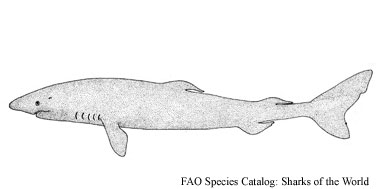
This large, heavy-set shark grows to an average 8-14 feet long but can get to be 24 feet. It has a short, rounded snout, small eyes, and relatively small dorsal fins. Although it is an apex predator, it is a slow swimmer, and likely ambushes its prey and scavenges for carrion. The Greenland shark’s flesh is poisonous when fresh, but can be eaten once it’s been dried. Because of its cold water habitat where humans normally wouldn’t swim, it is considered no harm to people.
Order: Squaliformes
Family: Dalatiidae
Genus: Somniosus
Species: microcephalus
Common Names
Other than its most familiar name as the Greenland shark, the Somniosus microcephalus has also been referred to as the sleeper shark, ground shark, gray shark, and gurry shark in English-speaking countries. Internationally, it is referred to as:
- Canadian: ekalukjuak, eqaludjuaq, eqalukuak, iqalugjuak, iqalujjuak, iqalukuak, laimargue
- Danish: ekalugssuak, ekaluggsup piara, ekaluksuak, eqalussuak, eqalusuak, gronlandsaj, havkal
- Dutch: Groenlandse haai
- English: oakettle
- Faeroese: hakelling
- Finish: holkeri
- French: laimargue du Groenland
- German: eishai, gronlandhai, grundhai,
- Icelandic: hakarl
- Italian: squalo di groenlandia lemargo
- Norwegian: hakjerring,
- Polish: rekin polarny
- Portuguese: tubarao da Gronelandia, tubarao de Gronelandia, tubarao-de-noite
- Rumanian: rechin de Groelanda
- Spanish: tiburon boreal, tollo boreal
- Swedish: hakaring
Importance to Humans
While the shark’s skin is poisonous when consumed raw, it becomes edible when the meat has been dried. The dried meat is widely used in Northern regions for sled dog, and occasionally human, consumption. (Idrobo and Berkes, 2012) Eskimos, for instance, use the dried skin as leather for boots and the lower dental bands of the shark as knives primarily for cutting hair. Its flesh contains high concentrations of urea and trimethylamine oxide, which induces an intoxicating, alcoholic effect. As a result, the natives of Greenland are known to call someone who is drunk “shark-sick.” Moreover, dogs that have been poisoned by the shark’s meat are often called “drunk.”
Danger to Humans
According to the International Shark Attack File (ISAF) there has only been one reported attack of the Greenland shark on a human. Around 1859 in Pond Inlet, Canada, it was reported that a Greenland shark was caught containing a human leg in its stomach. However, this story was merely a report and was never scientifically investigated or proven. The lack of recorded attacks may be due to the shark’s habitat, which is too cold to be populated by common swimmers, therefore, significantly reducing the chance of an attack on a human.
Conservation
It is speculated that the Greenland shark population is low, with an estimated doubling time of more than 14 years. Nevertheless, the shark supports fisheries in Norwegian, Iceland, and Greenland waters where it is captured for its liver oil. It is currently listed as “Near Threatened” by the World Conservation Union (IUCN). The IUCN is a global union of states, governmental agencies, and non-governmental organizations that assesses the conservation status of species.
> Check the status of the Greenland shark at the IUCN website.
Geographical Distribution
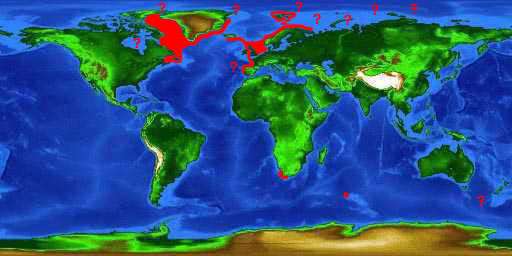
The shark is typically found in the Northern Atlantic and Arctic regions. It has been reported as far east as France and Portugal, as far west as the Gulf of St. Lawrence, and as far south as Cape Cod and North Carolina. There have even been a few sightings of the shark in the Southern Atlantic near Argentina and in Antarctic waters.
Habitat
The shark ranges in depths of 0-3,937 feet (0 to 1,200 m) and temperatures of 34-68°F (1 to 12°C). In the north, the shark migrates near shore in search of warmer waters. It is usually spotted near the surface during the winter and retreats to depths of 591-1,804 feet (180 to 550 m) during the summer. In southern waters the shark is found near continental shelves and slopes and is found at a depth of about 3,937 feet (1,200 m). In 1988, an unmanned submarine spotted a 20 feet (6 m) long male Greenland shark at a depth of 7,218 feet (2,200 m) at the wreck of the SS Central America, which sank off the coast of Savannah, Georgia in 1857. This is 3,281 feet (1,000 m) deeper than the maximum reported depth of the shark and 273 miles (440 km) south of its southernmost sighting in North Carolina (MacNeil et al., 2012).
Biology

Distinctive Features
The shark is characterized by its large, heavy-set body which gives it a sluggish appearance and movement. It has a short rounded snout, thin lips, and very small eyes. The dorsal and pectoral fins are very small, and it lacks spines in its dorsal fins. The gill openings are very small in comparison to their size and are located low on the sides of the shark’s head (MacNeil et al., 2012).
Coloration
The shark varies between a black, brown, and grey color. Although the shark is usually uniform in color, it is not uncommon for it to be marked with dark lines or white spots along its back and sides (MacNeil et al., 2012).
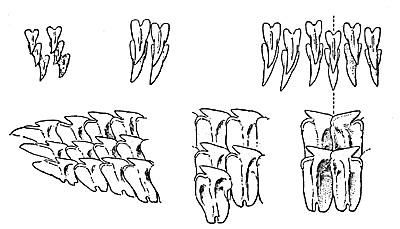
Dentition
The shark’s teeth have distinct top and bottom sets: The upper teeth are very thin and lack serrations, ranging in number from 48 to 52. The lower teeth, dissimilarly, are interlocking and are broad and square, containing short, smooth cusps that point outward and range in number from 50 to 52 (MacNeil et al., 2012).
Denticles
The shark’s denticles are uniform over the entire body. They are cone shaped and curved towards the rear of the shark and are organized in closely spaced longitudinal columns. Additionally, they have high axial crests and low lateral crests with the bases of the denticles possessing four sides (MacNeil et al., 2012).
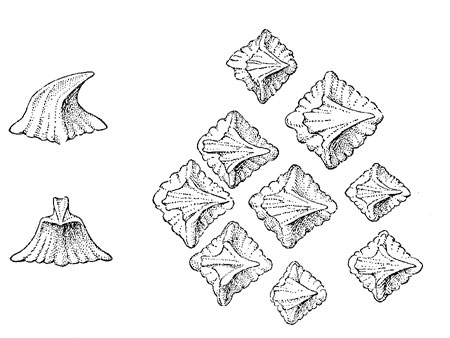
Size, Age, and Growth
Greenland sharks average in size from 244 to 427 cm (8-14) feet with females being the larger sex. This shark reaches a maximum length of about 640 cm (21 feet), although it may grow up to 730 cm (24 feet). The cold climate causes the sharks’ growth to be slowed (Nielsen et al., 2013).
Food Habits
The shark’s most common food consists of a large variety of ocean dwellers such as other small sharks, skates, eels, herring, capelin, char, various gadoids, redfish, sculpins, lumpfish, wolfish, and flounders. Marine mammals, such as seals and porpoises, are often taken by Greenland sharks despite it being characterized as a very sluggish creature. A few specimens have even been found to contain an entire reindeer and parts of a horse. The shark is also known to feed off carrion and is attracted to ill-smelling meat. They often congregate in large numbers around fishing operations (Nielsen et al., 2013).
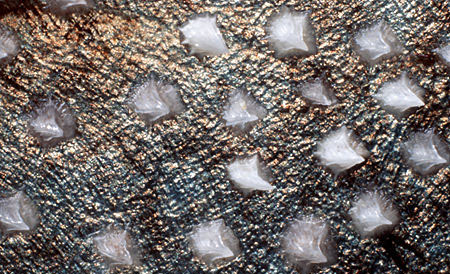
Reproduction
The Greenland shark is an ovoviviparous species. The female carries a large number of soft-shelled eggs eventually giving birth to full-term embryos. Some eggs have been reported to be as large as goose eggs. One 5 meter (16 ft) specimen was reported to have contained ten 38 cm (15 in) long full-term embryos in one of its uteri (Nielsen et al., 2013).
Predators
There are no known natural predators of the mature Greenland shark, which is most likely due to its massive size.
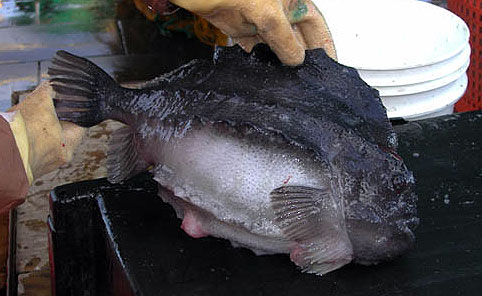
Parasites
A common parasite of the Greenland shark is Ommatokoita elongata. This copepod attaches itself to the eyes of the shark causing corneal lesions which lead to impaired vision and even partial blindness. However, this does not significantly affect the shark since it does not rely on keen vision. On most Greenland shark specimens, usually, only one eye is affected by a single female copepod. Some believe that the copepod is bioluminescent, attracting prey for the shark. However, there is no scientific evidence that supports this theory (Borucinska, Benz and Whiteley, 1998).
Taxonomy
This shark has been classified as Somniosus microcephalus by Bloch and Schneider (1801). Roughly translated, Somniosus pertains to “sleep” which describes the shark’s sluggish movement, and microcephalus literally means “small head.” In the past, it has also been referred to as Squalus squatina (non Linnaeus, 1758), Squalus carcharis (Gunnerus, 1776), Squalus microcephalus (Bloch & Schneider, 1801), Somniosus brevipinna (Lesueur, 1818), Squalus borealis (Scoresby, 1820), Squalus norvegianus (Blainville, 1825), Scymnus gunneri (Thienemann, 1828), Scymnus glacialis (Faber, 1829), Scymnus micropterus (Valenciennes, 1832), Leiodon echinatum (Wood, 1846), and Somniosus antarcticus (Whitley, 1939).
Prepared by: Dane Eagle
Revised by: Tyler Bowling & Julia Cofiño 2019
References
Borucinska, J., Benz, G. and Whiteley, H. (1998). Ocular lesions associated with attachment of the parasitic copepod Ommatokoita elongata (Grant) to corneas of Greenland sharks, Somniosus microcephalus (Bloch & Schneider). Journal of Fish Diseases, 21(6), pp.415-422.
Idrobo, C. and Berkes, F. (2012). Pangnirtung Inuit and the Greenland Shark: Co-producing Knowledge of a Little Discussed Species. Human Ecology, 40(3), pp.405-414.
MacNeil, M., McMeans, B., Hussey, N., Vecsei, P., Svavarsson, J., Kovacs, K., Lydersen, C., Treble, M., Skomal, G., Ramsey, M. and Fisk, A. (2012). Biology of the Greenland shark Somniosus microcephalus. Journal of Fish Biology, 80(5), pp.991-1018.
Nielsen, J., Hedeholm, R., Simon, M. and Steffensen, J. (2013). Distribution and feeding ecology of the Greenland shark (Somniosus microcephalus) in Greenland waters. Polar Biology, 37(1), pp.37-46.